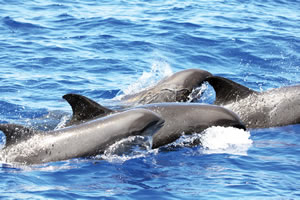Cataloging Hawaii’s Melon-heads

Hawaii has two distinct populations of melon-headed whales. Jessica Aschettino / Cascadia Research Collective photo
They have long been one of the most mysterious creatures in the ocean. But a recently published paper in the journal Marine Mammal Science is shedding new light on the melon-headed whale, and more importantly to us, the presence of two populations of the mammals in Hawaiian waters.
Jessica Aschettino is a research associate with Cascadia Research Collective and the senior author of the landmark effort. Aschettino worked on the melon-headed whale photo identification catalog for her master’s degree at Hawaii Pacific University.
“Very exciting and actually quite fascinating,” says Aschettino of her collaboration with other researchers and authors. “Melon-headed whales are typically found in groups of several hundred individuals, so at first it might be hard to imagine that there is intricate social structure beyond just a large group of animals.”
Very little dedicated research has been done on the melon-headed whale. In fact, this Hawaii catalog was the first photo-identification catalog of the species anywhere in the world.
For decades, the melonheaded whale was thought to be an open-ocean species that typically lived in deep water offshore. But long-term photo identification shows a small resident population lives on the Kona side of Hawaii Island, and a larger population has been seen throughout the island chain. Researchers also found the depth of the encounters with the mammals off Hawaii Island was much shallower than those with the main Hawaiian Islands population.
“It’s possible that many thousands of years ago a group of animals branched off from the main Hawaiian Islands population and began to spend more of their time in the restricted range off the northwest side of the island of Hawaii instead of moving between islands as the larger population does,” says Aschettino, who took many of the photos in the project. “These animals may have been taking advantage of different foraging niches or may have found more protection in the shallower waters off this part of the island. It’s very exciting that Hawaii has two unique populations.”
Aschettino says the two populations appear to be using “adjacent and sometimes even overlapping habitats” but there is no evidence that they are inter-mixing. She says through the photo-identification data, researchers have determined the individuals from the main Hawaiian Islands population make frequent movements among the islands of Hawaii, Oahu and Kauai. The smaller population off Kona does not venture far.
“Both populations have called Hawaii home for a long time,” she says after looking through thousands of photographs. “Re-sightings of animals date back up to 22 years for the Hawaii Island residents and up to 13 years for the main Hawaiian Islands population.”
And if you’re wondering, melon-headed whales are not a threat to humans. In fact, according to Aschettino the species actively avoids boats and swimmers.
“Like other small whales and dolphins, they are social animals and will often use their teeth when interacting with one another,” she says. “Large sharks and killer whales are likely their only two natural predators.”
The other predator appears to be man.
“Several individuals in both populations have dorsal fin disfigurements, which are indicative of interactions with fishery gear,” says Aschettino. “This species has also shown susceptibility to certain anthropogenic ocean noise as evidenced in 2004 when 150-200 animals entered the shallow waters of Hanalei Bay, Kaua’i, coincident with naval sonar training exercises.”
Like all marine mammals, melon-headed whales are protected by the Marine Mammal Protection Act, making it illegal to harass, hunt, capture or kill or even attempt to harm them in any way.
To read the entire paper, log on to www.cascadiaresearch.org or go to the Marine Mammal Science Early View website at https://onlinelibrary.wiley.co m/doi/10.1111/j.17487692.2011.00517.x/abstract. For more information on melon-headed whales, go to www.cascadiaresearch.org/hawaii/melonheadedwhale.htm.



